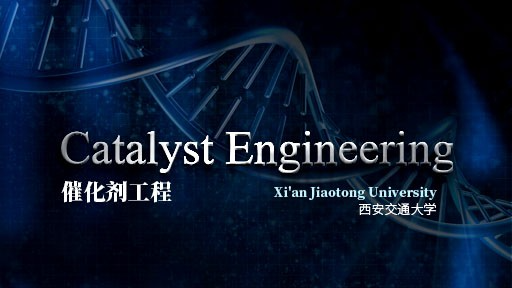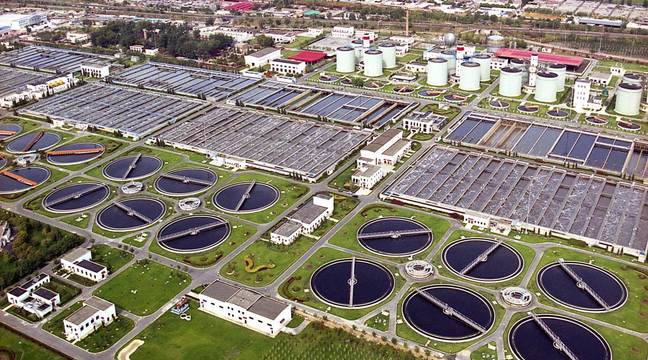
当前课程知识点:Water and Wastewater Treatment Engineering: Biochemical Technology > Chapter 4 Other aerobic biological wastewater treatment process > Section 4.1 Oxidation ditch process > Section 4.1 Oxidation ditch process
返回《Water and Wastewater Treatment Engineering: Biochemical Technology》慕课在线视频课程列表
返回《Water and Wastewater Treatment Engineering: Biochemical Technology》慕课在线视频列表
同学们好,欢迎来到水处理工程mooc课堂
今天我们开始学习第四章,废水好氧生物处理工艺的第三部分
其他的好氧生物工艺,主要内容
有这样四点,氧化沟工艺,A–B法工艺,SBR工艺,和MBR工艺
首先我们来学习第一节
氧化沟工艺,氧化沟在早期又称为氧化渠
或者是循环曝气池,是活性污泥法的一种变形
主要是在上个世纪的50年代在荷兰,由Pasveer博士
首先创造发明出来的,最早期是主要适用于
5000m3/d以下的小城市的,或者小城镇的
污水的处理,目前有各种规模的
城市污水处理厂或者是一些工业废水都有应用
关于氧化沟工艺,我们在这分别介绍氧化沟的
工作原理和基本的特征,介绍典型的氧化沟的工艺
最后介绍氧化沟的设计参数
这张图展示的就是,氧化沟的基本的工作原理
我们可以看出它主要采用一种环状跑道型的
曝气池作为它的主体反应器,在这个曝气池中间
采用表面曝气器作为它的主体的曝气设备
两种形式的曝气设备都可以,一种是
横轴式的曝气转刷,一种是竖轴式的叶轮曝气器
同时还需要设置二沉池,二沉池同样
起到泥水分离的作用,二沉池浓缩后的污泥
同样需要回流,进入氧化沟。这张图
给出了以氧化沟工艺作为主体处理单元的一个工艺流程
可以看出通常,原废水需要经过格栅
需要经过沉砂池,而通常没有初沉池,经过
沉砂池之后,出水直接进入氧化沟,
在氧化沟内得到生物降解,随后混合液
进入二沉池,二沉池回流污泥
沉淀以后的上清液作为出水排放。第二点
我们来介绍氧化沟的特征,氧化沟我们首先看
从构造上来看,它的基本特征是第一个
它的池体是比较狭长,池深比较浅,一般
是在3-5m之间,第二它的曝气装置
多采用表面机械曝气器,有竖轴的曝气器,像
低速曝气叶轮,或者是横轴式的曝气器,如
曝气转刷,或者曝气转盘。第三
它的进出水装置非常简单,那么从工艺上来看
氧化沟的特征主要体现在:第一,氧化沟内的流态
是一种循环混合态,就是在沟内混合液
呈推流式的快速流动,一般来说它的流速
在0.4-0.5m/s,进水流量跟沟内流量相比
通常都比较小,所以在另外一个程度上来看
氧化沟内的流态,是属于完全混合态的。第二是
氧化沟通常都采用很低的有机负荷,通常相当于
延时曝气法,所以它的出水水质非常好,第三
氧化沟具有非常好的抗冲击负荷的能力,对水温,水质
和水量等的变动有较好的适应性,第四
污泥产率低,剩余污泥的产量小,污泥龄
比较长,一般可以达到15-30天,第五
氧化沟还具有生物脱氮的功能,在好氧区
它具有很好的硝化的功能,而在缺氧区具有
很好的反硝化功能,在氧化沟中间通常
在曝气转盘的下游,是好氧区,而在曝气设备的上游
可能就是缺氧区,那么氧化沟,目前在世界上
主要有这四种形式,一种我们称为Carrousel氧化沟
一种称为Orbal氧化沟,第三种称为
交替工作式的氧化沟,第四种是曝气–沉淀
一体化的氧化沟,下面我们分别做一个简单的介绍
第一种称为Carrousel氧化沟,
它是一种平行多渠式的氧化沟,是上个世纪60年代
在荷兰,由DHV公司最先推出,它采用竖轴低速
表面曝气器,它具有很好的BOD5的去除效果
通常BOD5的去除率可以达95%以上
而且对总氮和总磷都有很好的去除,那么这张图
给出的就是Carrousel氧化沟的一个工作示意图
第二种我们称为Orbal式氧化沟,有的时候
又称同心圆式的氧化沟 ,可以看到,这样一个
氧化沟由三圈同心圆组成,废水从外侧进入
在每一条沟内多次循环以后最终
从内沟排出氧化沟系统,它的特点是
采用圆形或者是椭圆形的沟渠,能够充分的
利用水流的惯性,能够节省推动所需要的能耗
而且采用这种多沟串联可以减少水流短路
的现象,确保出水水质,这张图给出的
是Orbal氧化沟加上二沉池以后的一个
工艺流程,我们可以看到,污水从外沟进入
从内沟排出,进入二沉池,在二沉池内沉淀
下来的污泥通过污泥回流从外沟跟进水
同时进入氧化沟
第三种氧化沟,我们
称为交替工作式的氧化沟,这最早是由丹麦的Kruger
公司所开发的,有两沟或者三沟两种形式,
它的特点是对两沟或者三沟来说,它会用
其中的一条沟,交替的用做曝气池,或者
沉淀池,因此这个工艺不需要二沉池
也不需要污泥回流装置,但是由于交替运行
它降低了曝气转刷的利用率,在两沟式的
这种工艺中,曝气转刷的利用率可能
只有40%,而三沟式则相应的提高了一点
但也就是在58%左右。这两张图分别给出了
两种形式的两沟式的交替运行的氧化沟
可以看到一个是VR型,一个是D型,我们通常
用的最多的是这种三沟型的,那么两侧的A沟和C沟
交替作为曝气池和沉淀池,而中间的B沟一直
作为曝气池,原废水交替地从A沟或者C沟
进入,而出水则相应地从C沟和A沟流出,在这个
系统中间,曝气器的利用率,可以比较高
可以达到58%,因为交替运行的方式
为生物脱氮创造了很好的条件,所以,整个工艺
有非常良好的BOD5的去除效果和生物脱氮的效果
第四种氧化沟我们称为曝气沉淀一体化
氧化沟,它的基本原理是将沉淀池跟氧化沟
合建,主要是上个世纪80年代在美国得到开发
主要有三种形式:一种是侧沟式,一种是沉淀池
内置式的氧化沟,一种是内置船型的沉淀池的氧化沟
我们这张图,给出的就是侧沟型的
沉淀曝气一体式的氧化沟的工艺流程,可以看到
这两个作为二次沉淀池的侧渠主要起着
泥水分离和沉淀回流污泥的功能,而主沟
是作为曝气池。也有这种形式,我们把沉淀池
内置在氧化沟的一段中间,通过两端设置隔墙
减少水流的紊流,从上部收集出水
底部让回流污泥能够流过,也有在内部
设置这样的一个相当于船形的沉淀池,
从船的内部收集出水,船的底部让
沉淀下的污泥能够迅速的回流到主沟中间去
最后一点,我们来介绍一下氧化沟的一些
主要的设计参数,当处理对象为城市废水的时候
各项设计参数可参考如下的值,一般来说
氧化沟内,MLSS值在5000mg/L左右
MLVSS值在2000-4000mg/L左右,污泥龄
当仅要求去除BOD的时候,污泥龄可以
相对的短一点,在5-8天,而当有硝化反应或者是
反硝化反应的时候,污泥龄要求10-30天
对于水力停留时间HRT来说,相对于普通的
活性污泥曝气池就要长的多,一般会在
20、24小时甚至48小时,这当然主要是
根据对出水水质的要求而定,而污泥负荷
相对就非常低,可以是0.03-0.07kgBOD5/(kgMLSS·d)
容积负荷也非常低,一般是在0.1-0.2kgBOD5/(m3·d)
回流比是50%到150%,对于氧化沟有
两个特别的参数,一个是混合液在沟内的流速
我们希望控制在0.4-0.5m/s,而还有一个另外一个流速
是混合液在氧化沟沟底的流速,要控制在0.3m/s
以上,这节的内容就到这,谢谢
-Section 0.1 Development Status of Wastewater Treatment Process
--Section 0.1 Development Status of Wastewater Treatment Process
-Section 0.2 Typical Processes of Wastewater Biological Treatment
--Section 0.2 Typical Processes of Wastewater Biological Treatment
-Section 1.1 Principles of wastewater aerobic biological treatment
--1.1 Principles of wastewater aerobic biological treatment
-Section 1.2 Principles and determination of wastewater biodegradability
--1.2 Principles and determination of wastewater biodegradability
-Section 1.3 Principles of wastewater anaerobic biological treatment
--Section 1.3.1 Principles of wastewater anaerobic biological treatment(1)
--Section 1.3.2 Principles of wastewater anaerobic biological treatment(2)
-Section 1.4 Principles of wastewater biological nitrogen removal
--Section 1.4 Principles of wastewater biological nitrogen removal
-Section 1.5 Principles of wastewater biological phosphorus removal
--Section 1.5 Principles of wastewater biological phosphorus removal
-Chapter 1 Homework
-Section 2.1 Basic concept of activated sludge process
--Section 2.1.1 Basic concept of activated sludge process
--Section 2.1.2 Basic concept of activated sludge process
-Section 2.2 Growth rule of activated sludge and its application
--Section 2.2 Growth rule of activated sludge and its application
-Section 2.3 Running mode of activated sludge process
--Section 2.3.1 Running mode of activated sludge process(1)
--Section 2.3.2 Running mode of activated sludge process(2)
-Section 2.4 Kinetics of active sludge process
--Section 2.4.1 Kinetics of active sludge process(1)
--Section 2.4.2 Kinetics of active sludge process(2)
--Section 2.4.3 Kinetics of active sludge process(3)
--Research and Development of Kinetic Model of Activated Sludge Process
-Section 2.5 Principle, calculation and equipment of aeration
--Section 2.5.1 Principle, calculation and equipment of aeration(1)
--Section 2.5.2 Principle, calculation and equipment of aeration(2)
-Section 2.6 Designing of activated sludge process
--Section 2.6 Designing of activated sludge process
-Section 2.7 Operation and management of active sludge process
--Section 2.7.1 Operation and management of active sludge process (1)
--Section 2.7.2 Operation and management of active sludge process (2)
-Chapter 2 Homework
-Section 3.1 Basic principle of biofilm
--Section 3.1 Basic principle of biofilm
-Section 3.2 Biofilter process
--Section 3.2.1 Biofilter Process (1)
--Section 3.2.2 Biofilter process (2)
--Section 3.2.3 Biofilter process (3)
-Section 3.3 Biodisk process
-Section 3.4 Biological contact oxidation process
--Section 3.4 Biological contact oxidation process
-Section 3.5 Aerobic biological fluidized bed process
--Section 3.5 Aerobic biological fluidized bed process
-Chapter 3 Homework
-Section 4.1 Oxidation ditch process
--Section 4.1 Oxidation ditch process
-Section 4.2 A-B process
-Section 4.3 SBR process
-Section 4.4 MBR process
-Chapter 4 Homework
-Section 5.1 Overview and characteristics of development of anaerobic biological treatment
--Section 5.1 Overview and characteristics of development of anaerobic biological treatment
-Section 5.2 Anaerobic digester
--Section 5.2 Anaerobic digester
-Section 5.3 Anaerobic contact process and anaerobic filter process
--Section 5.3 Anaerobic contact process and anaerobic filter process
-Section 5.4 UASB process
-Section 5.5 Other anaerobic biological treatment process
--Section 5.5 Other anaerobic biological treatment process
-Section 5.6 Operation management of anaerobic biological treatment process
--Section 5.6 Operation management of anaerobic biological treatment process
-Chapter 5 Homework
-Section 6.1 Introduction
-Section 6.2 Biological nitrogen removal process and technology
--Section 6.2 Biological nitrogen removal process and technology
-Section 6.3 Biological phosphorus removal process and technology
--Section 6.3 Biological phosphorus removal process and technology
-Section 6.4 Simultaneous nitrogen and phosphorus removal process
--Section 6.4 Simultaneous nitrogen and phosphorus removal process
-Chapter 6 Homework
-Section 7 Natural biological treatment process
--Section 7 Natural biological treatment process
-Chapter 7 Homework
-Section 8.1 Source, nature and treatment of sludge
--Section 8.1 Source, nature and treatment of sludge
-Section 8.2 Sludge thickening and digestive stability
--Section 8.2 Sludge thickening and digestive stability
-Section 8.3 Sludge conditioning, dehydration and incineration
--Section 8.3 Sludge conditioning, dehydration and incineration
-Chapter 8 Homework
-Section 9 Wastewater Discharge and Reuse
--Section 9 Wastewater Discharge and Reuse
-Chapter 9 Homework


